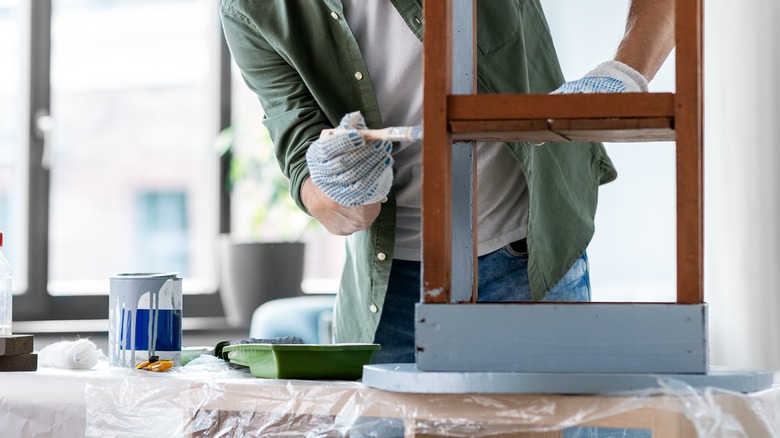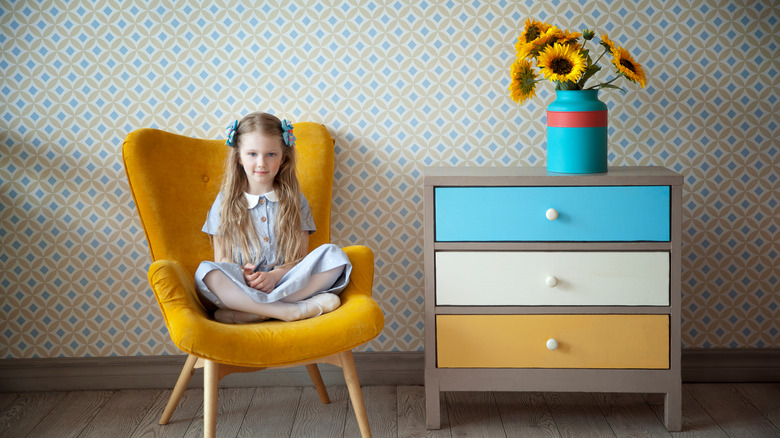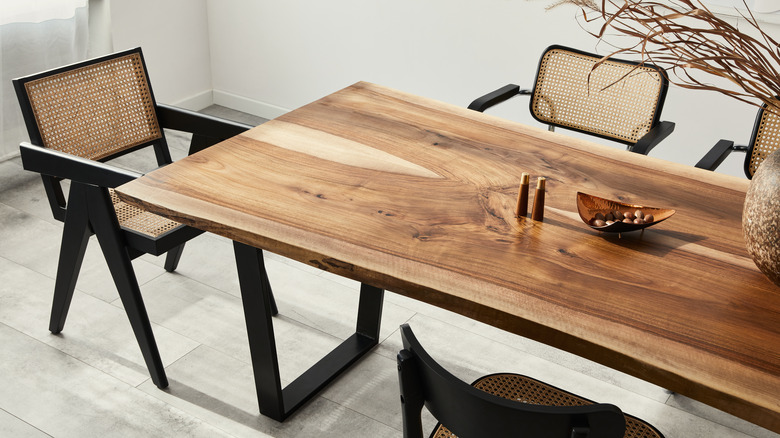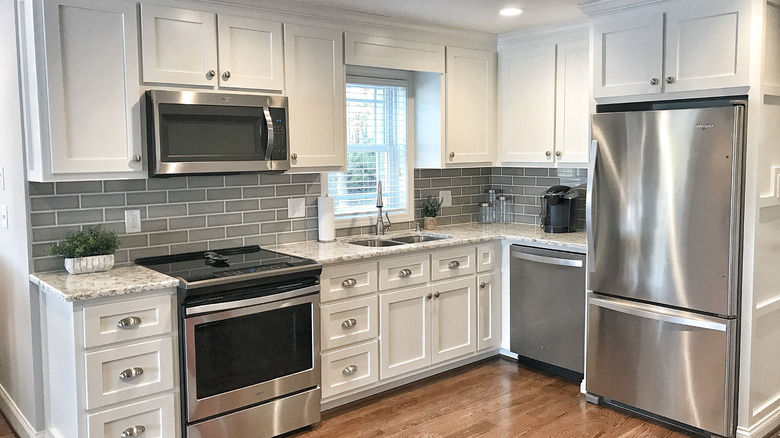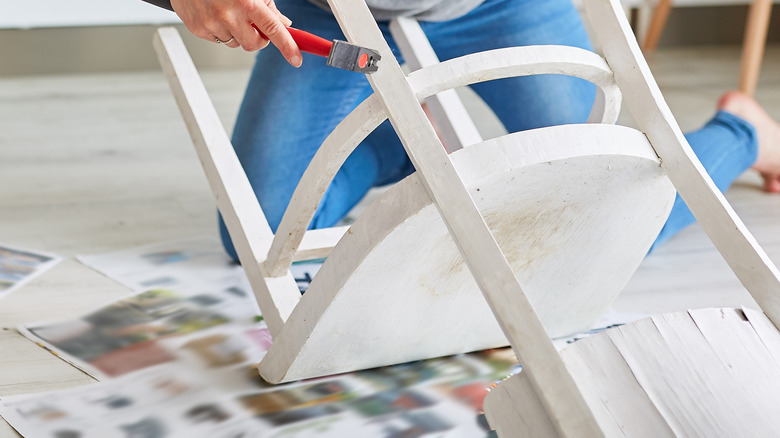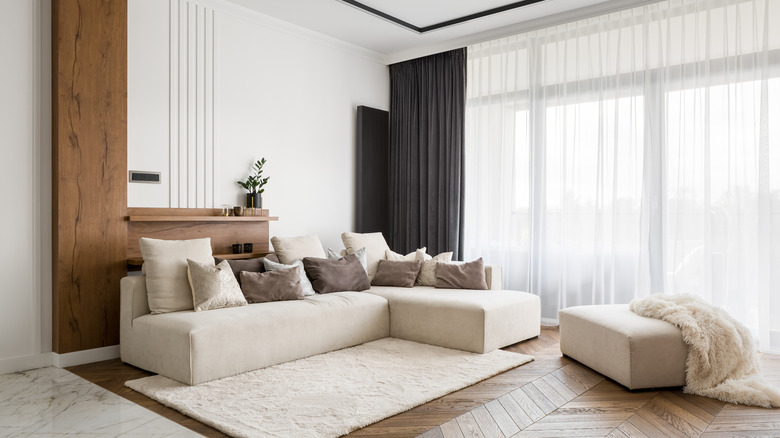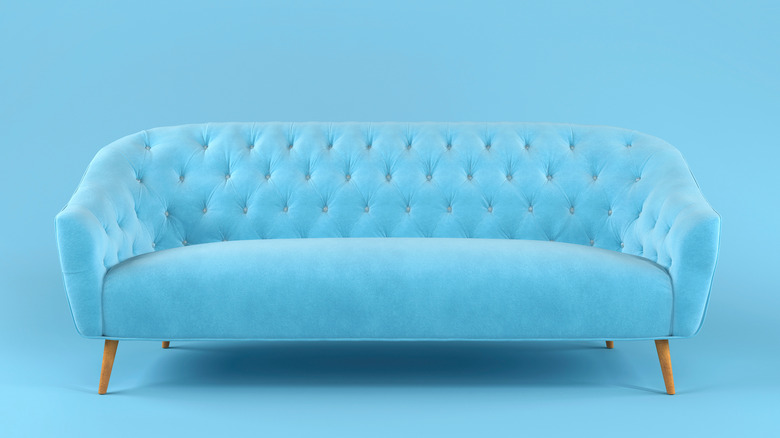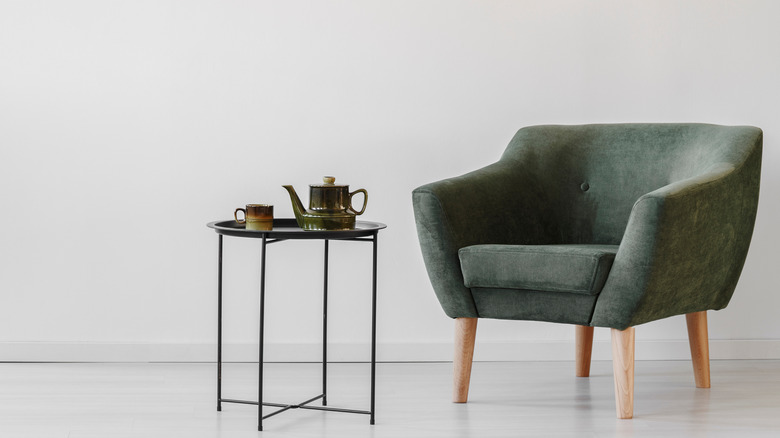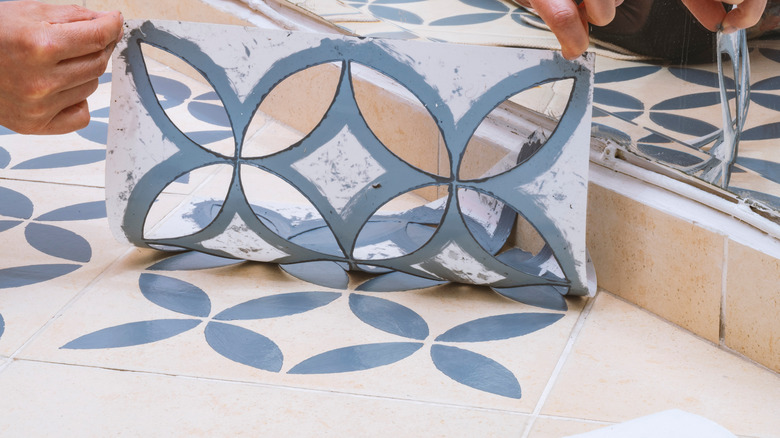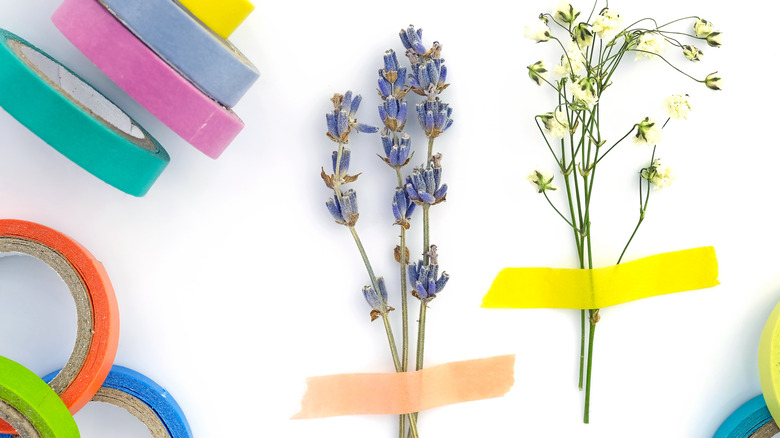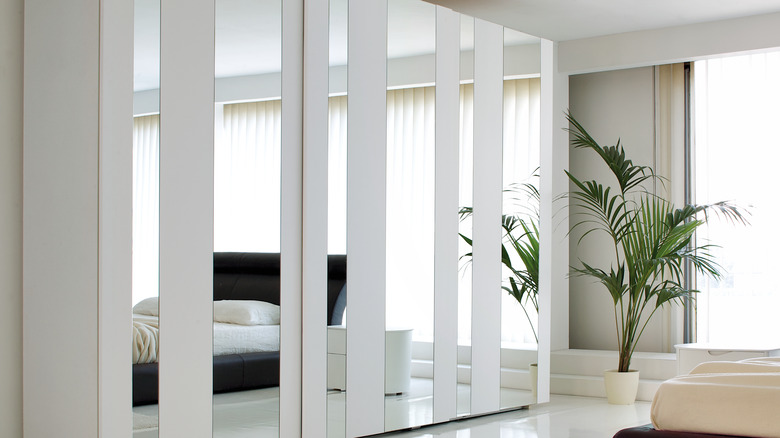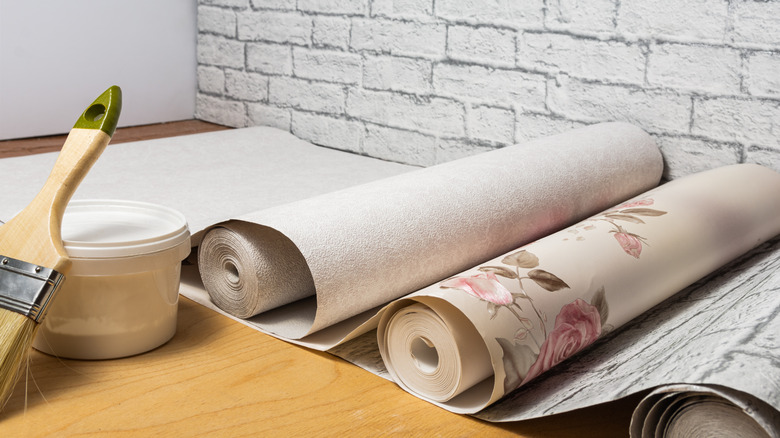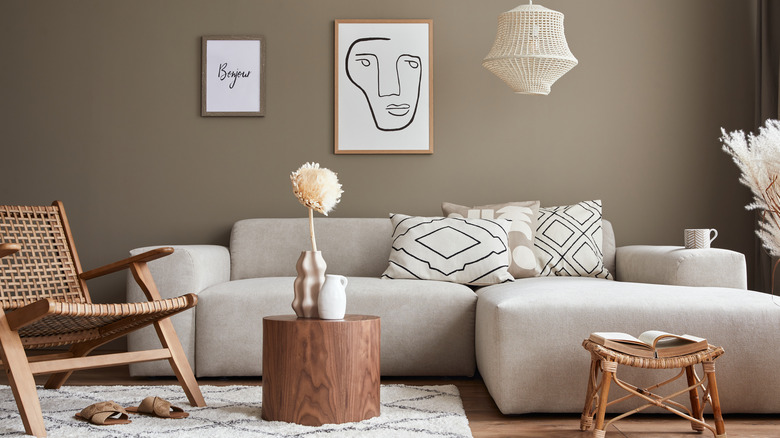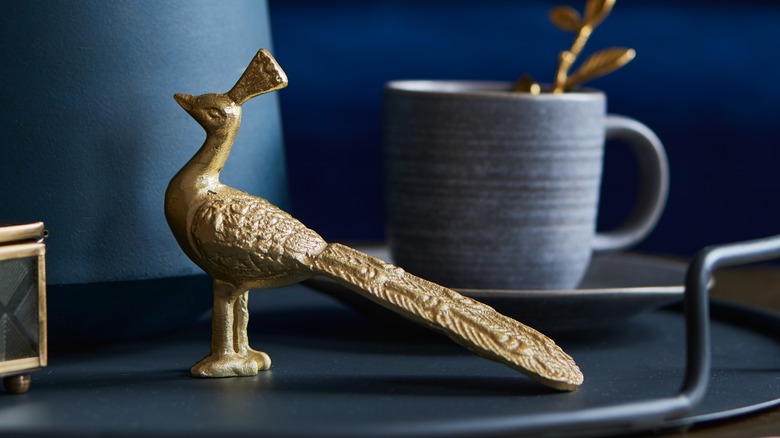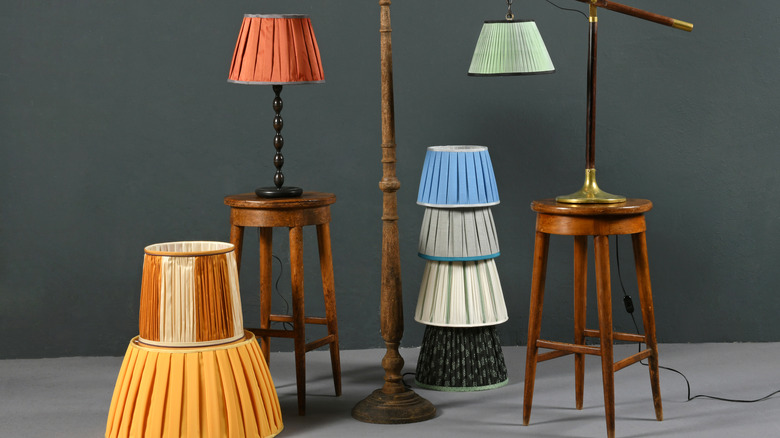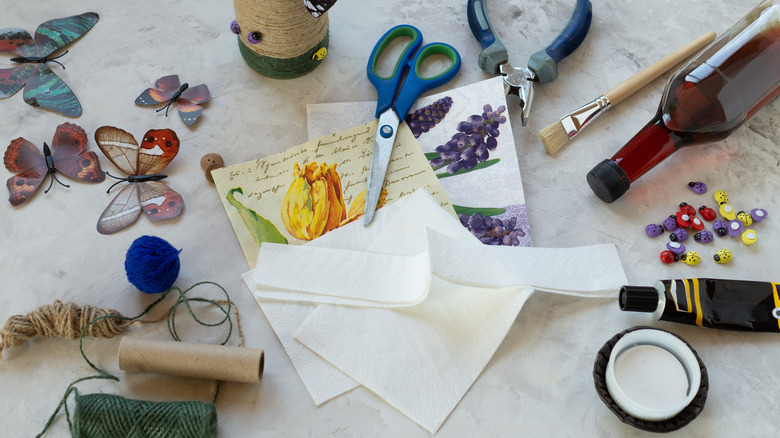How To Upgrade Furniture You Already Have For A New Look
When it comes to changing the atmosphere of your living space, it doesn't always have to depend on the renovation budget or time-consuming projects. Whether you want to save money, reduce your environmental impact, or fall in love with a thrift shop piece that doesn't fit in your existing space, there are plenty of ways you can upgrade your furniture in under a weekend.
According to HGTV, designer Nate Berkus claims home decor is ultimately about finding pieces that have significance to you and incorporating them into your space, even as you grow through life, move, and your style evolves. While it can be tempting to throw out old or gifted furniture that looks dated, restoring furniture to its former glory or an entirely new design is less expensive and retains sentimental value. Plus, it's more eco-friendly (via Danthe Furniture). New furniture releases over 1,000 times the CO2 into the atmosphere than restoring or refinishing an existing piece. Here are some great ways to upgrade furniture you already have for a new and improved look.
Get creative with contact paper
Contact paper is an affordable way to switch up your furniture and make frequent updates. Homesteady defines contact paper as a thin vinyl with adhesive on the back for organizing, decorating activities, and crafts. Many people may be familiar with the brand Con-Tact, which makes adhesive-backed vinyl, usually used as drawer linings. The trend of using Con-Tact paper for decoration quickly grew, and other companies jumped on, while Con-Tact expanded its brand to include prints, finishes, and chalkboard designs.
If you don't want to use contact paper on your furniture, you can also use peel-and-stick wallpaper, which is similar. Peel-and-stick wallpaper is usually a coated paper or vinyl product with a decorative front and adhesive on the back (via DIY Without Fear). However, peel-and-stick wallpaper holds up in fewer applications. For example, it doesn't do well on textured walls or high-use surfaces. Contact paper, based on installation, can hold up on countertops, backsplashes, privacy screens, and bathroom walls. To apply either contact paper or peel-and-stick wallpaper, clean the area with a degreasing product or alcohol and slowly remove the backing of the product inch by inch (via The DIY Mommy). Then slowly start smoothing it out as you continue. If there's bubbling, poke a tiny hole using a needle and smooth the area with a plastic spatula.
Refinish wood pieces
One of the best ways to clean up a thrift store find or an old hand-me-down piece is to refinish the wood. We often turn away from an item or discard it because it looks beaten up or outdated, but with a little TLC, a piece can come back to life and better suit our rooms. Before refinishing your furniture, it's essential to consider a few things. According to HGTV, higher-quality constructions do better than mass-produced furniture in refinishing projects. While newer pieces can still benefit from refinishing, the technique may differ based on how fragile the item is and the material type. For example, a plywood desk will require a simple sanding, stain, and sealer. On the other hand, a solid oak writing desk may require stripping, sanding, putty, staining, and possibly a special sealer. Additionally, older pieces are typically sturdy enough that they won't break during the refinishing process, and it's harder to damage the wood by accident.
For a painted thrifted piece, the paint usually covers up imperfections, dents, and stains (via Amish Outlet Store). While this shouldn't be a dealbreaker, it does mean you'll be placing extra work into the piece and possibly seeing some imperfections like dents or stains. However, this can add charm to older furnishings, especially in Japandi-style homes where imperfections are a highlighted part of the design aesthetic.
Update your existing hardware
The simplest and most affordable way to upgrade your furniture is by swapping out the decorative hardware. According to The Spruce, a great way to spice up furnishings is to update standard and contractor-grade knobs with statement hardware. You can also mix the finishes of your hardware to create a multidimensional feel (via Sterling Homes Calgary). You can mix metals or use different hardware on top cabinets than you would on your pantry door. However, designers suggest if you're mixing themes and colors, limit yourself to three elements per room.
If you're unable to switch out your existing hardware or can't find a decorative piece, customize your hardware with a bit of DIY magic. This is one of the hacks will change how you DIY. One common trend in DIY design is to use craft-grade gold metallic paint and rub it on contractor-grade hardware (via YouTube). This trick creates a varnished and distressed look that's perfect in farmhouse and glam-inspired rooms. You can also use polymer clay to create a marbling effect on existing hardware (via A Beautiful Mess).
Slap on a coat of paint
One of the easiest ways to freshen up a dated piece of furniture is to give it a coat of paint. This tip works well on pieces that you cannot refinish. Painting furniture may seem daunting because there are so many decor options and products available. As Erin Spain points out, it's almost as easy as painting a wall. Before painting your furniture piece, it's important to prep it according to the material and the product you're using. Properly prepping allows your paint to last longer and resist chipping. You have many paint options, including popular latex and chalk paint. Latex is a good option because of the low VOC, different finishes, and the array of colors (via The Spruce). Chalk paint gives the furniture an old-time feel and is a buildable product that allows you to customize the piece.
If you're unsure which color paint to use, many AI apps allow you to take pictures of your room and change the color. Use a basic photo editor or photoshop to get an accurate mock-up (via Salvaged Inspirations). Additionally, under the professional or for contractors section of commercial paint companies, you should be able to download photoshop and image files of exact color matches that you can plug into CAD or Photoshop or overlay using a photo editor.
Reupholster your chairs
Reupholstering furniture is a great way to step up your existing decor and refresh a room. This option is helpful if a piece has delicate or damaged fabric and you want it swapped out for something more sturdy or stain-resistant. It's also an easy and affordable way to take existing investment pieces like a couch and make them fit with a room's new paint color or interior design. MyDomaine points out that faux leather, suede, and microsuede are easy to maintain and clean, making them great for homes with children. Also, twill and basketweave fabrics hide stains well. If you have pets, microfiber and ultra-suede fabrics are resistant to scratching.
While reupholstering a piece yourself is cheaper, many people choose to get it professionally done. Turning to professionals ensures high quality, especially for large-scale investment pieces or large items like a bulky couch. To reupholster by yourself, remove the existing upholstery, and pay attention to the construction of your furniture. You can take pictures to help you piece it back together again. Next, use the original fabric as a template to cut out the new fabric. Older furniture may include unsafe, flame-retardant materials. Toxic chemicals are in about 85 percent of couches made between 1984 and 2010 (via Mother Jones). Think about replacing old chair cushioning with newer organic material.
Paint fabric
If reupholstering isn't an option, you can also paint virtually most fabrics. According to A Piece of Rainbow, cotton and poly blends are the best materials to paint. Although you can paint over textured fabrics like velvet and woven threads, using liquid dye may be an easier option.
You can use different paints on fabric pieces, including chalk paint, fabric medium mixed with acrylic, or latex paint. However, almost every material has a specially designed paint, meaning you don't have to mess with mixing fabric medium into acrylic if you don't want to (via This Old House). While mixing your own paint is a cheaper option, it can leave an uncomfortable crunchy cast. Chalk paint is an affordable option that reduces the cast and acts as more of a dye. However, if you can get your hands on specially designed paint for your material, you can preserve the original texture and softness. Make sure when you paint fabric that you keep the surface moist. This tip helps the paint spread smoothly and absorb into the fabric.
Swap out legs of existing pieces
Next to changing the hardware, swapping out legs on furniture is one of the most affordable decor hacks. It also allows you to take a piece and make it smaller or taller, transforming dining chairs into barstools or coffee tables into benches. According to Our Home Made Easy, it's also a great way to change the decor style of a piece. For example, hairpin legs can become glam or boho, while craftsman-style legs lend themselves to regency and regal homes.
You can remove legs from all types of furniture, including older pieces with built-ins and newer pieces with screws or pins. Swap out the legs by taking off the support structure, which is often held in place by nails. In older furnishings, you'll most likely remove interlocking pegs or staples (via DoItYourself). Once you remove the support structure, the leg should be loose enough to pull off. However, vintage legs may be challenging to remove and require some force. You can do this by lightly hitting the area where the support was with a hammer or the back of pliers. To install new legs, drill them into the base or screw them into place.
Use stencils and stamps
If your room has eclectic, artsy, or bohemian style, updating your furniture with stencils and stamps is an ideal way to add pattern. You can purchase these items from a craft or home improvement store, make your own, or source them from a wallpaper manufacturer. Additionally, you can buy stamps at a craft store or find a decor stamp manufacturer online. These stamps are made specifically for furniture, but basic craft book stamps will also work.
When you stencil or stamp your furniture, you can use any paint you would use for painting furniture. Just ensure it's pigmented and doesn't need to build up to achieve the desired effect. If you want a more mute and vintage look, go for chalk paint. Or, if you want a bright and colorful detail, opt for latex or acrylic paint.
According to Salvaged Inspirations, you can make your own template using a thick transparent sheet, which you can purchase at any craft store, a template to trace, and an Exacto knife. To stamp or stencil your furniture, pour the paint onto a plate and brush it onto a stencil with a round stenciling brush or use a stamp to lightly dab it onto the piece (via YouTube). When you reload your brush or stamp with paint, lightly dab off excess onto a secondary surface like a second plate or napkin.
Add washi tape
If you're renting and want to incorporate colorful patterns in your space or don't want to commit to long-term decor, washi tape is the perfect solution. Life of Colour says washi tape is a multipurpose tape typically used for crafts and journaling. What makes washi tape unique is that it features natural fibers like hemp and bamboo, making it soft and durable. The low adhesive content lets you remove it without any damage (via Paper Mart).
Washi tape is available in many different colors, patterns, and sizes. You can also get washi tape that incorporates gold foiling and glitter, making it a perfect detail accent for children's rooms or temporary party decor. You can use washi tape on the dowels of a chair to create a colorful pattern without spending any time painting (via Apartment Therapy). You can also apply it to low-use countertops and desks to add color and patterns. This tape is especially great for kids' parties because you can remove it quickly without harming the furniture.
Install mirrors
If you're looking for a glam hack for cheap, you can take standard furniture and add dollar store or craft mirrors onto the surface. Typically, mirrored furnishings range from $150 upwards to $4,000 based on size and quality. However, if you have a spare weekend and some elbow grease, you can turn your old nightstand or dresser into a designer dupe. Just make sure you know the best mirror cleaning trick.
According to Cleverly Me, it's best to use furniture that doesn't have any intricate or raised carvings on the surface. Next, remove the knobs and measure your piece. Based on the look you're going for, you can use mirrored tiles from a hardware store or dollar store mirrored backs. If you need a custom size, a hardware store should be able to cut the mirrored tiles for no extra cost. Before you apply your tiles, paint the furniture a base color. This color will poke through the joints where there are no mirrors. Use metallic silver or gold spray paint on your piece if you want a glam look. If you want a dramatic look, paint it a dark color, like black, or use a stain for exposed dark wood grain. Once the paint is dry, affix the tiles with a strong marble or stone glue and use clamps to hold them in place. Once everything is in place, attach your knobs with the same strong glue and allow proper setting time, typically 12 to 24 hours.
Use paintable wallpaper
While it's intended for walls, usually to hide damage or add texture, paintable wallpaper is a staple in DIY decor. There are plenty of innovative ways to use wallpaper in the home. Paintable wallpaper comes in large white pre-pasted rolls and features different patterns and textures, from roses to scrolls and intricate Gregorian-inspired detailing. You can apply it on walls, ceilings, or wood pieces. It's also known as textured wallpaper. However, be careful when searching online because textured wallpaper is a general term for any wallpaper with texture, including colored and coated wallpaper.
According to Designed Decor, this decor hack is ideal for damaged and scuffed pieces, especially on chipped or stained surfaces. Repairing them is often costly or time-consuming. Textured wallpaper can also add a french farmhouse and chateau detailing to any home since so many available patterns follow regency trends. To apply paintable wallpaper, follow the instructions on the label. Each brand features individual instructions, but most tend to use water by either dipping the entire roll in water or lightly misting it and the surface to activate the adhesive. You can also utilize the decoupage method and use Mod Podge to layer it on (via Girl In The Garage). Once the wallpaper is applied, allow it to cure and then paint, ensuring it dries completely. When the paint is dry, apply an even coat of sealer, making sure to reapply it at least once a year.
Add rattan
Rattan is all the rage in home decor right now. According to Decor House Furniture, rattan furniture is resistant to rain, snow, and freezing temperatures, meaning it's perfect for outdoor use. It's also low maintenance, fade-resistant, and lightweight, making it an ideal addition to the interior decor. You can add rolls of rattan to virtually any surface to add a natural and warm look to a room. When purchasing rattan rolls, you may see them listed under many different names, like webbing, cane, or wicker (via Ohoh Deco). Each one refers to rattan but indicates different patterns or spacing.
You can add rattan to the kitchen or console cabinets instead of chicken wire or burlap. Alternatively, you can staple it to wood frames for artwork on end tables (via Remodelista). You can also use rattan to create a makeshift headboard by putting it onto an existing plywood headboard, affixing it onto the plastic with glue, or pinning it in place. While you can paint rattan any color, you need to prime it properly. Use spray paint or a paint sprayer (via H20Bungalow). Since rattan is highly detailed, it's important to use thin paint that won't cause build-up, meaning it's best to avoid latex and acrylic paint.
Apply leaf to tables
One of the quickest ways to decorate an existing surface is to add metallic leaf. According to Pigmentti, adding gold leaf to furniture or art is called gilding. This technique is popular in interior design and art because it adds artistic flair and value to pieces. While it comes in different karats and shades, you can also buy craft leaf or dutch gold with no metal content for low prices at hobby stores or online.
To gild your furniture, prep it by removing dust and grime from the surface (via Home Dzine). Next, paint it a base color. This color will differ based on your leaf shade. If you're using gold, paint the base a light red tone, which helps the gold look warmer. If you're painting with silver or aluminum paint, use a blue undercoat. Next, paint the surface with thin glue, carefully place the leaf down, and smooth it out. Lastly, protect the finish with a strong sealer. You can also add leaf to small areas instead of large surfaces. It works well for adding texture to mirrors and vases. To do this, apply a water-based glue onto the surface and sprinkle the leaf on top of it, brushing it away as it falls (via YouTube). You can use shredded leaf for this job, which usually comes in a jar.
Decorate your lamps
Decorating lamps is a great way to customize your space. According to Better Homes & Gardens, there are many ways you can customize a light, including painting the lampshade with leftover interior home paint or using RIT all-purpose dye to customize a white shade. You can also glue tassels to the bottom seam with fabric glue to give a vintage or Hollywood regency vibe. Additionally, you can use food coloring and corn starch to create watercolor effects on your lampshade.
You can spruce up a lamp base with just a little bit of spray paint (via Decor Hint). Brands like Rust-Oleum sell paint with different textures and finishes, which make your customization options endless. However, before you paint, make sure you properly prep the surface by taping any electrical wiring and using light grit sandpaper to help the paint penetrate. Additionally, if your spray paint doesn't have a primer built-in, make sure to prime the surface. You can also mix baking powder and acrylic paint to make glass bases look like ceramics (via House Beautiful). This tip is a great way to bring Scandinavian and boho themes into a room.
Decoupage your furniture
Similar to paintable wallpaper, the decoupage technique is a great way to add color, texture, and an artistic flair to your existing furniture. According to Artsy Fartsy Life, decoupage is a decorating style that involves gluing paper, tissue, stamps, and stickers onto materials like glass, wood, or plastic. You can apply this design hack to bold interiors or pair it with light colors and natural elements to create a statement piece in boho rooms.
Start by prepping the surface by cleaning it and using light sandpaper to help the paint adhere (via Girl in The Garage). Next, prime it with a strong primer and apply one or two thick coats. Next, sand the piece again and start decoupaging any way you want. Think of decoupage as collaging on furniture. After the decoupage sets, apply a sealer and reapply it at least once a year to protect the surface.
